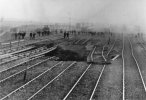I've been plotting my branch line of interest on the 1844-45 OS map sheet. The L&Y started to construct the line in 1870, but what surprised me was just how close one old mine shaft was to the tracks...
Have a look please at this photo from the Steaming North site (click on the photo to enlarge):
The photo explained:
The train is on the branch Up line, the track on the right is the Up siding next to the roofless carriage shed.
This train is passing the home signal of Gt. Harwood station.
Now, somewhere from the signal post (coming towards us) and between both of those two tracks is or was a coal mine shaft, and it's clear the L&Y when planning and building this line would have wanted to avoid laying tracks directly over the shaft. I believe this coal mine was part of a group of mines know as Clayton Collieries which closed circa 1858, that's only 12 years before 1870.
Sorry for citing my old branch line again, but was it common for railway companies to place track so close to mine shafts?
Would the L&Y have capped the shaft?
Filled it in?
And what's the object in the bottom left of the photo? is that the capped shaft or the end of the platform ramp?
What other examples of shafts that close to railway lines are there from around the country?
Thanks,
Andy.
Have a look please at this photo from the Steaming North site (click on the photo to enlarge):
The photo explained:
The train is on the branch Up line, the track on the right is the Up siding next to the roofless carriage shed.
This train is passing the home signal of Gt. Harwood station.
Now, somewhere from the signal post (coming towards us) and between both of those two tracks is or was a coal mine shaft, and it's clear the L&Y when planning and building this line would have wanted to avoid laying tracks directly over the shaft. I believe this coal mine was part of a group of mines know as Clayton Collieries which closed circa 1858, that's only 12 years before 1870.
Sorry for citing my old branch line again, but was it common for railway companies to place track so close to mine shafts?
Would the L&Y have capped the shaft?
Filled it in?
And what's the object in the bottom left of the photo? is that the capped shaft or the end of the platform ramp?
What other examples of shafts that close to railway lines are there from around the country?
Thanks,
Andy.

